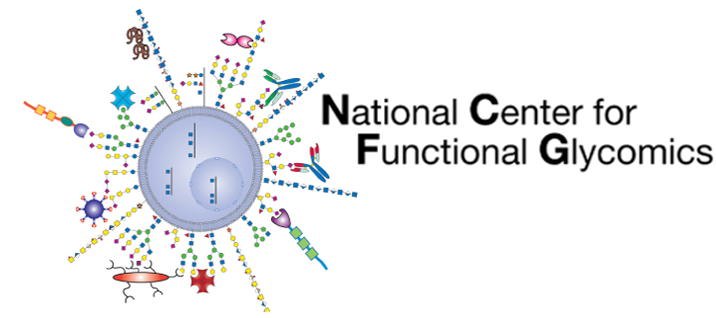By: Richard D. Cummings
While the N-glycosylation sequon N-X-S/T in glycoproteins of plants, fungi, and animals, is well known, there are many reports of alternative sequons for N-glycosylation in animals (1), including the sequences -N-X-C- (2-4), -N-X-V- (5,6), -N-V-E- (7), -N-X-A- (8), -N-X-G- (9), -N-N-C- (10), and the unusual glutamine rather than asparagine in the sequon -Q-G-T- (11).
While O-glycans with GalNAc α-linked to Ser/Thr are well known, the modification of GalNAc α-linked to Tyr residues is also common (12). This modification on Tyr is resistant to the common β-elimination used for O-glycans, as that requires linkage to Ser or Thr.
C-mannosylation of Man-Trp in C-C linkages is known, but other modification of Trp can occur, as in C-glucosylation of Trp and N-mannosylation of Trp (13).
Of the 20 canonical amino acids, 10 of them and their derivatives may be glycosylated, including Asn, Arg, Cys, Gln, HydroxyLys, HydroxyPro, Ser, Thr, Trp, and Tyr (14-19), and all but the glycosylation of HydroxyPro have been shown to occur in animal cells.
References:
1. Dutta, D., Mandal, C., and Mandal, C. (2017) Unusual glycosylation of proteins: Beyond the universal sequon and other amino acids. Biochim Biophys Acta Gen Subj 1861, 3096-3108
2. Vance, B. A., Wu, W., Ribaudo, R. K., Segal, D. M., and Kearse, K. P. (1997) Multiple dimeric forms of human CD69 result from differential addition of N-glycans to typical (Asn-X-Ser/Thr) and atypical (Asn-X-cys) glycosylation motifs. The Journal of biological chemistry 272, 23117-23122
3. Miletich, J. P., and Broze, G. J., Jr. (1990) Beta protein C is not glycosylated at asparagine 329. The rate of translation may influence the frequency of usage at asparagine-X-cysteine sites. The Journal of biological chemistry 265, 11397-11404
4. Yasuda, D., Imura, Y., Ishii, S., Shimizu, T., and Nakamura, M. (2015) The atypical N-glycosylation motif, Asn-Cys-Cys, in human GPR109A is required for normal cell surface expression and intracellular signaling. FASEB J 29, 2412-2422
5. Zielinska, D. F., Gnad, F., Wisniewski, J. R., and Mann, M. (2010) Precision mapping of an in vivo N-glycoproteome reveals rigid topological and sequence constraints. Cell 141, 897-907
6. Sun, S., and Zhang, H. (2015) Identification and Validation of Atypical N-Glycosylation Sites. Anal Chem 87, 11948-11951
7. Gross, J., Grass, S., Davis, A. E., Gilmore-Erdmann, P., Townsend, R. R., and St Geme, J. W., 3rd. (2008) The Haemophilus influenzae HMW1 adhesin is a glycoprotein with an unusual N-linked carbohydrate modification. The Journal of biological chemistry 283, 26010-26015
8. Franc, V., Yang, Y., and Heck, A. J. (2017) Proteoform Profile Mapping of the Human Serum Complement Component C9 Revealing Unexpected New Features of N-, O-, and C-Glycosylation. Anal Chem 89, 3483-3491
9. Valliere-Douglass, J. F., Kodama, P., Mujacic, M., Brady, L. J., Wang, W., Wallace, A., Yan, B., Reddy, P., Treuheit, M. J., and Balland, A. (2009) Asparagine-linked oligosaccharides present on a non-consensus amino acid sequence in the CH1 domain of human antibodies. The Journal of biological chemistry 284, 32493-32506
10. Sato, C., Kim, J. H., Abe, Y., Saito, K., Yokoyama, S., and Kohda, D. (2000) Characterization of the N-oligosaccharides attached to the atypical Asn-X-Cys sequence of recombinant human epidermal growth factor receptor. J Biochem 127, 65-72
11. Valliere-Douglass, J. F., Eakin, C. M., Wallace, A., Ketchem, R. R., Wang, W., Treuheit, M. J., and Balland, A. (2010) Glutamine-linked and non-consensus asparagine-linked oligosaccharides present in human recombinant antibodies define novel protein glycosylation motifs. The Journal of biological chemistry 285, 16012-16022
12. Xia, L., Bellomo, T. R., Gibadullin, R., Congdon, M. D., Edmondson, E. F., Li, M., Wlodawer, A., Li, C., Temme, J. S., Patel, P., Butcher, D., and Gildersleeve, J. C. (2022) Development of a GalNAc-Tyrosine-Specific Monoclonal Antibody and Detection of Tyrosine O-GalNAcylation in Numerous Human Tissues and Cell Lines. J Am Chem Soc 144, 16410-16422
13. Minakata, S., Manabe, S., Inai, Y., Ikezaki, M., Nishitsuji, K., Ito, Y., and Ihara, Y. (2021) Protein C-Mannosylation and C-Mannosyl Tryptophan in Chemical Biology and Medicine. Molecules 26
14. Spiro, R. G. (2002) Protein glycosylation: nature, distribution, enzymatic formation, and disease implications of glycopeptide bonds. Glycobiology 12, 43R-56R
15. Schjoldager, K. T., Narimatsu, Y., Joshi, H. J., and Clausen, H. (2020) Global view of human protein glycosylation pathways and functions. Nat Rev Mol Cell Biol 21, 729-749
16. Stepper, J., Shastri, S., Loo, T. S., Preston, J. C., Novak, P., Man, P., Moore, C. H., Havlicek, V., Patchett, M. L., and Norris, G. E. (2011) Cysteine S-glycosylation, a new post-translational modification found in glycopeptide bacteriocins. FEBS letters 585, 645-650
17. Olsen, E. H., Rahbek-Nielsen, H., Thogersen, I. B., Roepstorff, P., and Enghild, J. J. (1998) Posttranslational modifications of human inter-alpha-inhibitor: identification of glycans and disulfide bridges in heavy chains 1 and 2. Biochemistry 37, 408-416
18. Maynard, J. C., Burlingame, A. L., and Medzihradszky, K. F. (2016) Cysteine S-linked N-acetylglucosamine (S-GlcNAcylation), A New Post-translational Modification in Mammals. Mol Cell Proteomics 15, 3405-3411
19. Xiao, H., and Wu, R. (2017) Global and Site-Specific Analysis Revealing Unexpected and Extensive Protein S-GlcNAcylation in Human Cells. Anal Chem 89, 3656-3663
